Telomere And Autism
Unraveling the Link Between Cellular Aging and Autism Spectrum Disorder

Understanding the Biological Intersections of Telomeres and Autism
Recent scientific research has uncovered significant associations between telomere dynamics—specifically telomere length and oxidative damage—and autism spectrum disorder (ASD). This comprehensive review explores the genetic, molecular, and environmental factors influencing telomere biology in autism, investigating their potential as biomarkers, the impact of oxidative stress, and the underlying mechanisms that connect cellular aging processes to neurodevelopmental outcomes.
Telomere Length Differences in Children and Families with Autism
How does telomere length compare among children with ASD, typically developing children, and unaffected siblings?
Children with autism spectrum disorder (ASD) generally show significantly shorter telomere lengths (TL) in peripheral blood leukocytes compared to their typically developing (TD) peers. For example, a study found that children with ASD had a shorter relative telomere length (RTL) with a statistical significance of p<0.001. Similarly, when compared to unaffected siblings, children with ASD tend to have even more reduced TL, although siblings often exhibit intermediate TL values.
This pattern suggests a biological association between shortened TL and autism. The research indicates a dose-response relationship, where the shorter the telomeres, the higher the likelihood of an autism diagnosis. Such differences in telomere length are not only markers of cellular aging but may also serve as potential biomarkers for early detection of ASD.
Molecular and Cellular Evidence of Telomere Shortening in ASD
What is the relationship between telomere length and autism spectrum disorder (ASD)?
Recent scientific findings reinforce a significant connection between telomere length (TL) and autism spectrum disorder. Researchers have observed that children and adolescents diagnosed with ASD exhibit notably shorter telomeres in peripheral blood leukocytes compared to their typically developing (TD) counterparts. Multiple studies, employing techniques such as real-time PCR on saliva samples, confirm this pattern of telomere shortening.
The association extends beyond children. In families with an affected child, unaffected siblings tend to have telomere lengths that fall between those of ASD children and TD children, indicating a possible hereditary or environmental influence on telomere dynamics. High-risk families—those with a diagnosed child—have demonstrated significantly shorter telomeres across various family members, including mothers and infants, further highlighting this biological link.
Quantitative analysis of telomere length in children with ASD
Measurement of telomere length through relative telomere length (RTL) assays has shown consistent results. Autistic children have significantly shorter RTL compared to healthy controls, with studies reporting a decrease of over 40% in some cases. These reductions correlate with increased severity of symptoms, especially sensory issues, which are core features of ASD.
In some investigations, there is a clear dose-response pattern: the shorter the telomere length, the higher the odds of an autism diagnosis. This information supports the potential use of RTL as a biomarker for early detection. Notably, in male children with autism, shortened RTL is also associated with decreased expression of TERRA, a telomere-related transcript, and increased telomeric oxidative damage.
Correlation of telomere length with autism severity, especially sensory symptoms
Shortened telomeres are particularly linked to increased sensory challenges in ASD. Elevated levels of oxidative stress markers—such as 8-hydroxy-2-deoxyguanosine (8-OHdG)—are common in children with ASD, indicating oxidative damage to telomeres. This damage is more pronounced in autistic children than in TD children or unaffected siblings.
Swings in antioxidant activity, including reduced catalase (CAT) activity and elevated superoxide dismutase (SOD) activity, have been observed. Such imbalances contribute to an oxidative environment that accelerates telomere shortening.
Significantly, a positive correlation exists between telomere length and LINE-1 methylation levels—a marker of genomic stability—further supporting a link between telomere integrity and ASD severity. Shorter telomeres have been associated with more severe behavioral and sensory symptoms, emphasizing their potential role in disease manifestation.
The role of telomere shortening as a potential biomarker for early diagnosis
Given their associations with ASD, telomere length and telomeric oxidation levels are promising candidates as biomarkers. Receiver operating characteristic (ROC) curve analyses have demonstrated high predictive accuracy—area under the curve values often exceeding 0.8—for both RTL and LINE-1 methylation status.
Furthermore, interventions such as family training programs have been linked to longer telomere lengths in affected children, suggesting the environment and behavioral modifications might influence telomere dynamics.
Understanding telomere biology offers valuable insights into the cellular processes underlying ASD. Shortened telomeres, coupled with increased oxidative damage, reflect cellular aging and stress, which may contribute to or result from the neurodevelopmental challenges of ASD.
| Study Focus | Key Findings | Implications |
|---|---|---|
| Telomere length measurement | Shorter in children and family members with ASD, correlates with severity | Biomarker potential for early detection |
| Oxidative stress markers | Elevated 8-OHdG and altered antioxidant activity in ASD children | Indicates oxidative damage to telomeres |
| Genetic and epigenetic factors | Decreased LINE-1 methylation, TERRA expression changes | Molecular signatures associated with ASD |
These collective results bolster the view that telomere shortening and associated oxidative stress are integral to understanding ASD at a cellular level, highlighting new avenues for diagnosis and possibly targeted therapies.
The Impact of Oxidative Stress on Telomere Integrity and Autism
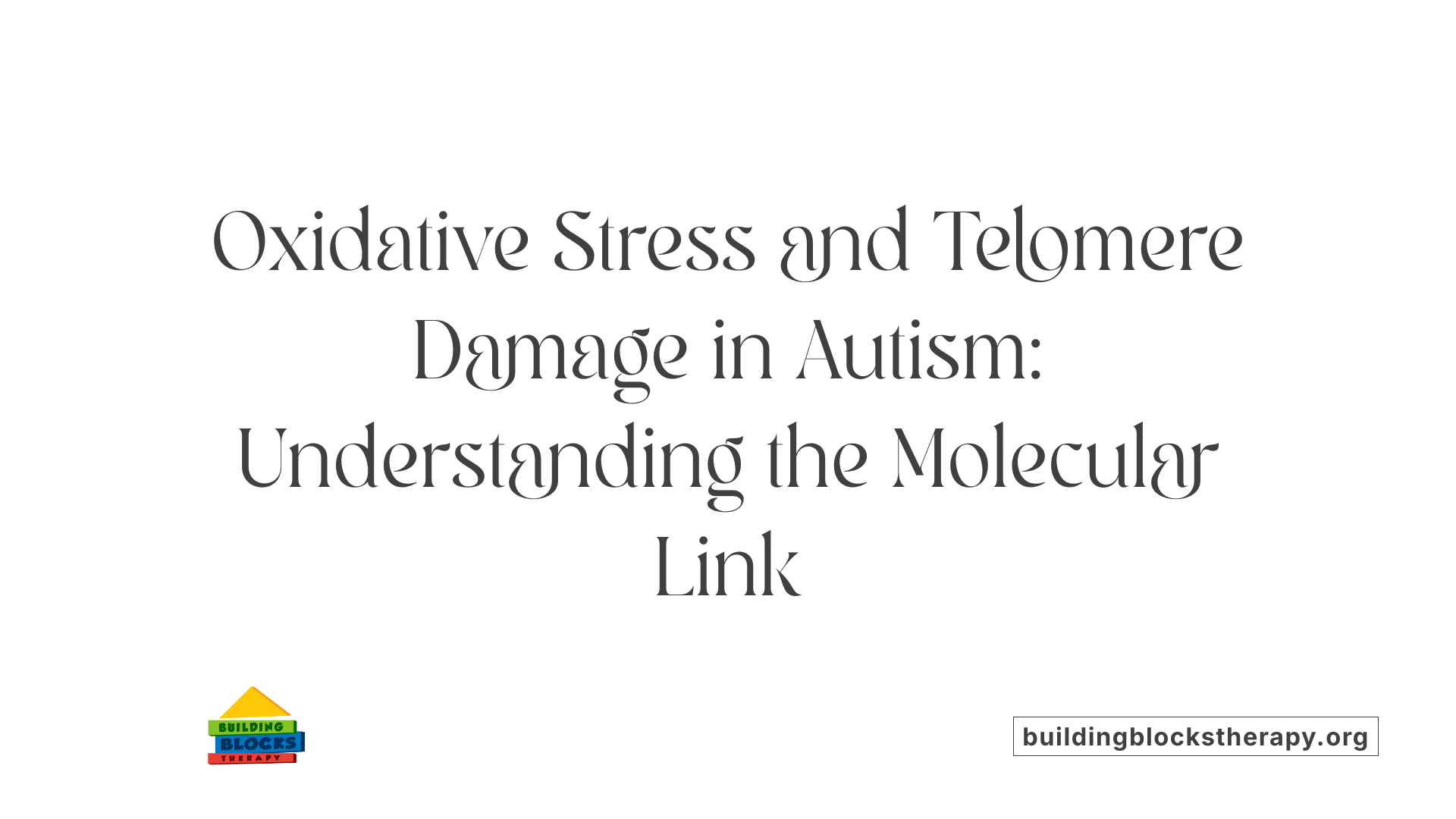
What role does oxidative stress play in telomere biology and autism?
Oxidative stress is a critical factor influencing telomere biology, especially in the context of autism spectrum disorder (ASD). Children with ASD exhibit significantly higher levels of oxidative damage to telomeric DNA, as evidenced by increased markers such as 8-hydroxy-2-deoxyguanosine (8-OHdG). This elevated damage indicates that reactive oxygen species (ROS) induce oxidative lesions within telomeres, accelerating their shortening.
Research has shown that children with ASD have reduced activity of antioxidant enzymes like catalase and superoxide dismutase (SOD), which normally help neutralize harmful free radicals. This imbalance, known as oxidative stress, results in an environment where DNA, including telomeric regions, is more vulnerable to damage.
Such oxidative damage is compounded by mitochondrial dysfunction observed in ASD, with higher mitochondrial DNA copy numbers pointing toward increased oxidative stress. This disruption in cellular energy and increased free radical production exacerbate telomere erosion.
The relationship between increased oxidative DNA damage and telomere shortening
Telomeres are repetitive DNA sequences at the ends of chromosomes that protect genetic data during cell division. They are highly sensitive to oxidative stress because their G-rich sequences are prone to damage.
In children with ASD, the accumulation of telomeric oxidized bases correlates with shortened telomere length (RTL). The presence of oxidative lesions hampers the replication process, leading to premature telomere shortening. This process is particularly pronounced in ASD, where oxidative stress markers are elevated.
Studies have also found a positive association between oxidative markers and shorter RTL, suggesting that oxidative DNA damage directly contributes to telomere attrition. This shortening process may impair cellular function, affecting tissues involved in neurodevelopment.
Oxidative stress-mediated mechanisms contributing to autism severity and progression
The neurological and behavioral symptoms of ASD may be influenced by oxidative stress-induced telomere dysfunction. Shortened telomeres can trigger cellular aging and senescence, impacting neuronal health and brain development.
Furthermore, increased oxidative stress can enhance neuroinflammation and disrupt synaptic functioning, which are hallmarks of ASD pathology. The imbalance between free radicals and antioxidants not only damages DNA but also impairs signaling pathways important for neural plasticity.
Increased telomeric oxidative damage and shortening have been associated with more severe sensory symptoms in ASD, suggesting that oxidative stress-related telomere dynamics could serve as biomarkers for disease severity.
In summary, oxidative stress significantly impacts telomere integrity by promoting telomeric DNA damage and shortening. This mechanism contributes to the cellular dysfunction observed in ASD, underscoring the importance of managing oxidative factors as potential therapeutic targets. Elevated oxidative damage and compromised telomere maintenance may not only serve as biomarkers for early diagnosis but also offer pathways for interventions aiming to slow disease progression.
Genetic Factors Influencing Telomere Dynamics and Autism Risk
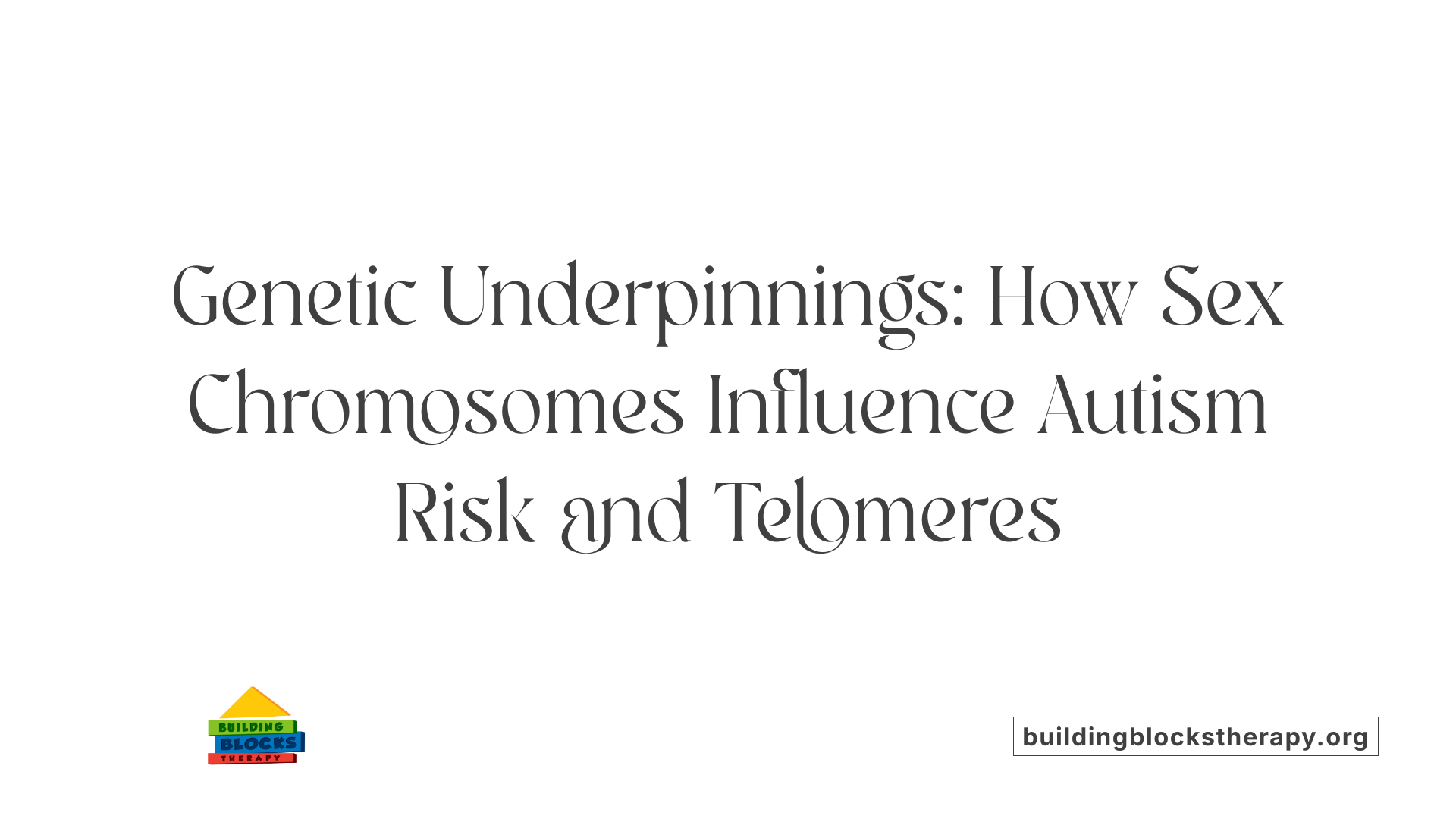
Are there known genetic factors, such as sex chromosomes, linked to autism risk?
Research highlights the importance of sex chromosomes in understanding autism spectrum disorder (ASD). The Y chromosome, in particular, has been associated with an increased risk of ASD. Studies indicate that individuals with a higher number of Y chromosomes, such as in cases of supernumerary Y chromosomes, have roughly double the likelihood of being diagnosed with ASD. Conversely, simply having an additional X chromosome does not seem to elevate risk significantly.
Genes on the X chromosome also play a crucial role. Notably, mutations in the NLGN4X gene, which is located on the X chromosome, have been linked to ASD. This gene is involved in synaptic function and neurodevelopment.
Its homolog, NLGN4Y, found on the Y chromosome, shares similarities but has limited functionality. These genetic differences may partly explain why ASD is more prevalent in males than in females, pointing to underlying genetic influences.
Further, some regions within the X chromosome, known as risk-enriched regions (RERs), have shown stronger associations with ASD, especially when damaging mutations are present. These findings suggest that these genomic hotspots could influence neurodevelopment and contribute to autism susceptibility.
Overall, genetic factors involving the sex chromosomes—including specific regions on the X chromosome and the Y chromosome—substantially affect autism risk. Understanding these elements enhances our comprehension of the biological underpinnings behind the sex differences observed in ASD prevalence.
| Genetic Factor | Impact on Autism Risk | Additional Details |
|---|---|---|
| Extra Y chromosome (+Y) | Increased risk | Doubles likelihood of ASD (OR ≈ 2) |
| Extra X chromosome (+X) | No significant increase | Additional X alone does not raise risk |
| NLGN4X gene mutations | Higher susceptibility | Implicated in synaptic development |
| NLGN4Y gene | Limited functionality | Homolog on Y chromosome, less impact |
| X chromosome risk regions (RERs) | Stronger association with ASD | Variants here may influence neurodevelopment |
This genetic perspective underscores the importance of sex chromosomes and specific gene regions in ASD risk, complementing insights into telomere dynamics and cellular aging in autism.
Epigenetic Modifications and Their Relationship to Telomere Length and Autism
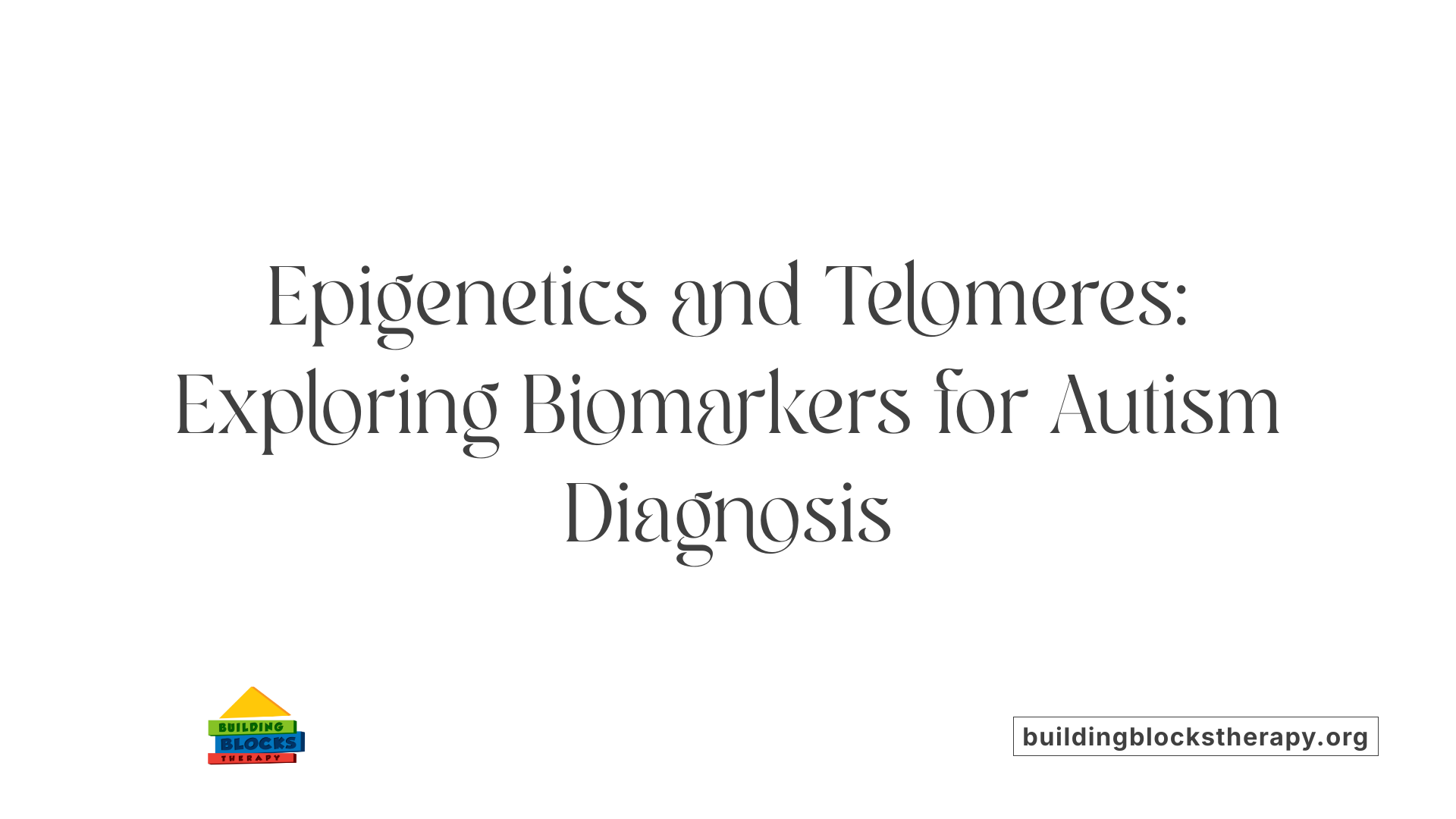
What are LINE-1 methylation levels in children with ASD?
In children diagnosed with autism spectrum disorder (ASD), studies consistently report decreased LINE-1 methylation levels compared to typically developing (TD) children. LINE-1 elements are repetitive sequences in the genome whose methylation status serves as a marker for global DNA methylation levels. A significant reduction in LINE-1 methylation (about 7-8% lower) has been observed in autistic children, indicating overall hypomethylation associated with the disorder.
This hypomethylation suggests alterations in the epigenetic regulation of the genome, which could impact gene expression related to ASD. The decrease in methylation levels at LINE-1 sites reflects a state of genomic instability and has been confirmed across different studies using blood samples from pediatric populations.
How does methylation pattern correlate with telomere length?
Research shows a positive correlation between LINE-1 methylation and telomere length in children with ASD. Specifically, shorter telomeres are linked with decreased LINE-1 methylation levels. One study reported a correlation coefficient of 0.439, indicating a moderate positive relationship, with hypomethylation accompanying telomere shortening.
This relationship suggests that as oxidative stress and DNA damage increase—factors common in ASD—both telomeres and global methylation patterns are adversely affected. The concurrent changes highlight a molecular interplay where epigenetic modifications and telomere dynamics may influence each other, contributing to the neurodevelopmental abnormalities seen in ASD.
Potential of LINE-1 methylation as a biomarker for autism
Given the significant differences in LINE-1 methylation between autistic and healthy individuals, researchers are exploring its potential as a biomarker. The high diagnostic accuracy demonstrated through receiver operating characteristic (ROC) curve analysis, with an area under the curve (AUC) around 0.89, underscores its promise.
Combined with telomere length measurements, LINE-1 methylation improves the ability to differentiate ASD cases from controls. Testing in accessible tissues like blood or saliva allows for minimally invasive assessment, supporting its feasibility for early screening.
Nevertheless, further validation in larger, diverse populations is essential to establish standardized thresholds and ensure robustness across age groups and sexes. Ultimately, LINE-1 methylation could become part of a panel of biological markers, aiding in early diagnosis and understanding of the molecular underpinnings of ASD.
| Aspect | Findings | Significance |
|---|---|---|
| LINE-1 methylation in ASD | Decreased in children with ASD (~79.8%) vs. controls (~88.2%) | Marker for epigenetic changes associated with ASD |
| Telomere length in ASD | Shorter RTL and telomeric oxidative damage | Indicators of cellular aging and oxidative stress |
| Correlation | Positive between methylation and telomere length (r=0.439) | Suggests interconnected molecular pathways |
| Diagnostic potential | ROC AUC > 0.8 | Promising biomarker for early detection |
While the promise of LINE-1 methylation as an autism biomarker is evident, ongoing research is focused on refining measurement techniques and understanding the biological significance. Combining epigenetic markers like LINE-1 methylation with telomere length assessments offers a compelling approach to improving early diagnosis and elucidating ASD's complex molecular landscape.
Impact of Environmental and Parental Factors on Telomere Length in Autism Contexts
How do parental age and environmental factors influence telomere length in autism?
Research indicates that several biological and environmental elements can influence telomere length (TL) in individuals with autism spectrum disorder (ASD). One notable factor is parental age at the time of a child's birth. Interestingly, older paternal or maternal age has been linked to longer telomeres in children with ASD, suggesting a complex interaction where genetic inheritance and environmental exposures come into play.
Typically, aging is associated with telomere shortening. However, in families with children who have ASD, this pattern may shift. The study highlights that increased parental age can modify the usual age-related TL decline, possibly leading to longer telomeres in offspring. This atypical effect enhances our understanding of how genetics and environment intertwine in ASD development.
Environmental stressors also play a significant role in telomere dynamics. Families facing high levels of psychological or social stress often exhibit signs of accelerated telomere attrition. Such oxidative stress, resulting from increased free radicals, can damage telomeric DNA, contributing to cellular aging and potentially influencing autism severity.
Supportive interventions, especially those aimed at reducing family stress through programs like family training, have shown promising results. These interventions are associated with preservation or even elongation of leukocyte telomeres. This suggests that improving the family environment and reducing stress could positively impact cellular aging markers and might correlate with better clinical outcomes in children with ASD.
In addition, oxidative stress markers such as increased 8-OHdG content and decreased antioxidant enzyme activities (like catalase and superoxide dismutase) are observed in children with ASD. These oxidative damages not only relate to shorter TL but also may be a contributing factor to the disease’s progression.
| Factor | Effect on Telomere Length | Additional Notes |
|---|---|---|
| Parental age at birth | Older age linked to longer telomeres in ASD children | Contrasts with typical age-related shortening |
| Environmental stressors | Accelerated telomere shortening due to oxidative damage | Stress management could help preserve TL |
| Early interventions | Associated with longer leukocyte telomeres | Family training may mitigate stress effects |
Understanding these influences emphasizes the importance of both genetic and environmental factors in autobiological aging processes within ASD. Managing environmental stress and supporting family well-being might offer avenues to influence telomere dynamics in affected children.
Overall, parental age and environmental conditions significantly influence telomere length in ASD populations. These factors may not only impact biological aging markers but also potentially affect the severity and progression of autism symptoms. Interventions aimed at stress reduction and promoting healthy environments could play a role in modulating these biological effects, offering hope for improved management of ASD.
Clinical and Therapeutic Perspectives on Telomere Biology in Autism
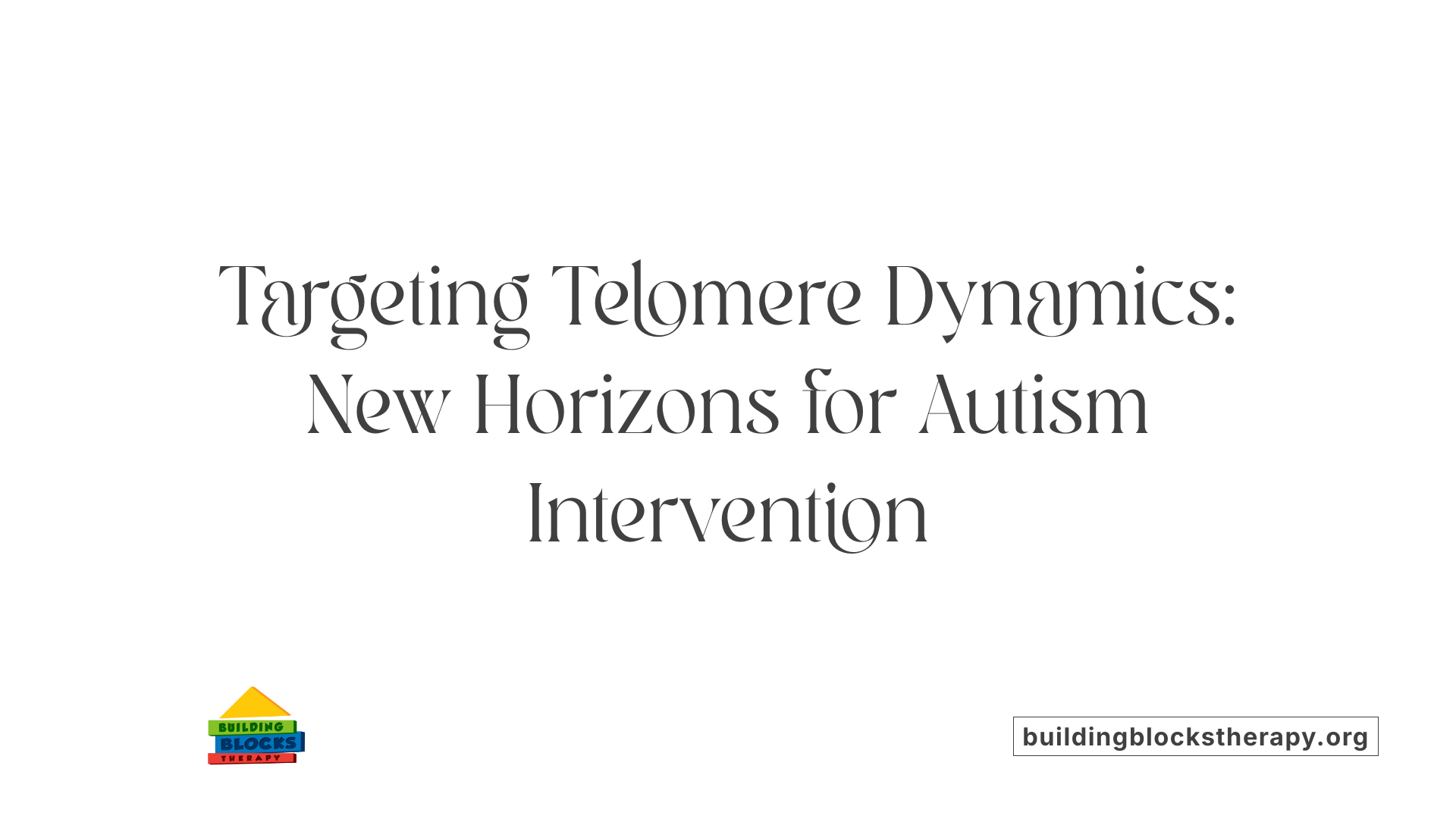
How could potential interventions aim at reducing oxidative stress and preserving telomeres?
Research shows that children with ASD have higher oxidative stress levels, including increased damage to telomeres, which are protective caps at the end of chromosomes. Elevated oxidative stress accelerates telomere shortening, contributing to cellular aging and possibly disease severity. Protecting telomeres by reducing oxidative stress might help mitigate some ASD symptoms.
Antioxidant therapies, such as supplementing with compounds like vitamin E, vitamin C, superoxide dismutase (SOD), and catalase, could potentially minimize oxidative damage. Lifestyle interventions promoting a diet rich in antioxidants and stress reduction techniques may also support telomere maintenance. These approaches aim to balance the body's oxidative-antioxidant system, slowing telomere attrition.
What are the therapeutic implications of targeting telomere maintenance mechanisms?
Targeting telomere length and its regulatory processes presents novel avenues for ASD treatment. Approaches may include telomerase activation therapies, which boost the enzyme responsible for maintaining telomere length. Although still in experimental stages, telomerase activators could potentially prolong telomeres and improve cellular health.
Furthermore, interventions aimed at enhancing telomeric DNA repair mechanisms or reducing telomeric oxidation are being explored. Such strategies may help mitigate cellular senescence and oxidative DNA damage, possibly alleviating some neurodevelopmental issues associated with ASD.
Why is early detection using telomere and oxidative markers vital in clinical practice?
Early identification of biological markers like shortened telomeres and elevated oxidative stress can play a crucial role in diagnosing ASD at an earlier stage. Since shortened telomeres correlate with ASD severity and oxidative damage indicates ongoing cellular stress, measuring these markers in young children or at-risk families can facilitate timely intervention.
Saliva, blood, or other accessible tissue samples for telomere length and oxidative stress analysis are promising tools in clinical practice. Using these biomarkers can help clinicians tailor early interventions, monitor disease progression, and evaluate treatment efficacy, ultimately improving outcomes for children with ASD.
| Aspect | Diagnostic Potential | Therapeutic Strategy | Measurement Method | Support for Early Detection |
|---|---|---|---|---|
| Telomere length | Yes | Telomerase activation | PCR, saliva/blood tests | Highly promising |
| Oxidative stress | Yes | Antioxidant supplements | Oxidative damage assays | Valuable |
| Family screening | Yes | Stress management, lifestyle adjustments | Blood, saliva | Critical |
Understanding telomere dynamics and oxidative stress in ASD provides a foundation for developing precise, early, and effective interventions. These biomarkers hold promise for integrating into routine clinical assessments, enhancing personalized treatment approaches.
Future Directions and Research Gaps in Telomere and Autism Studies
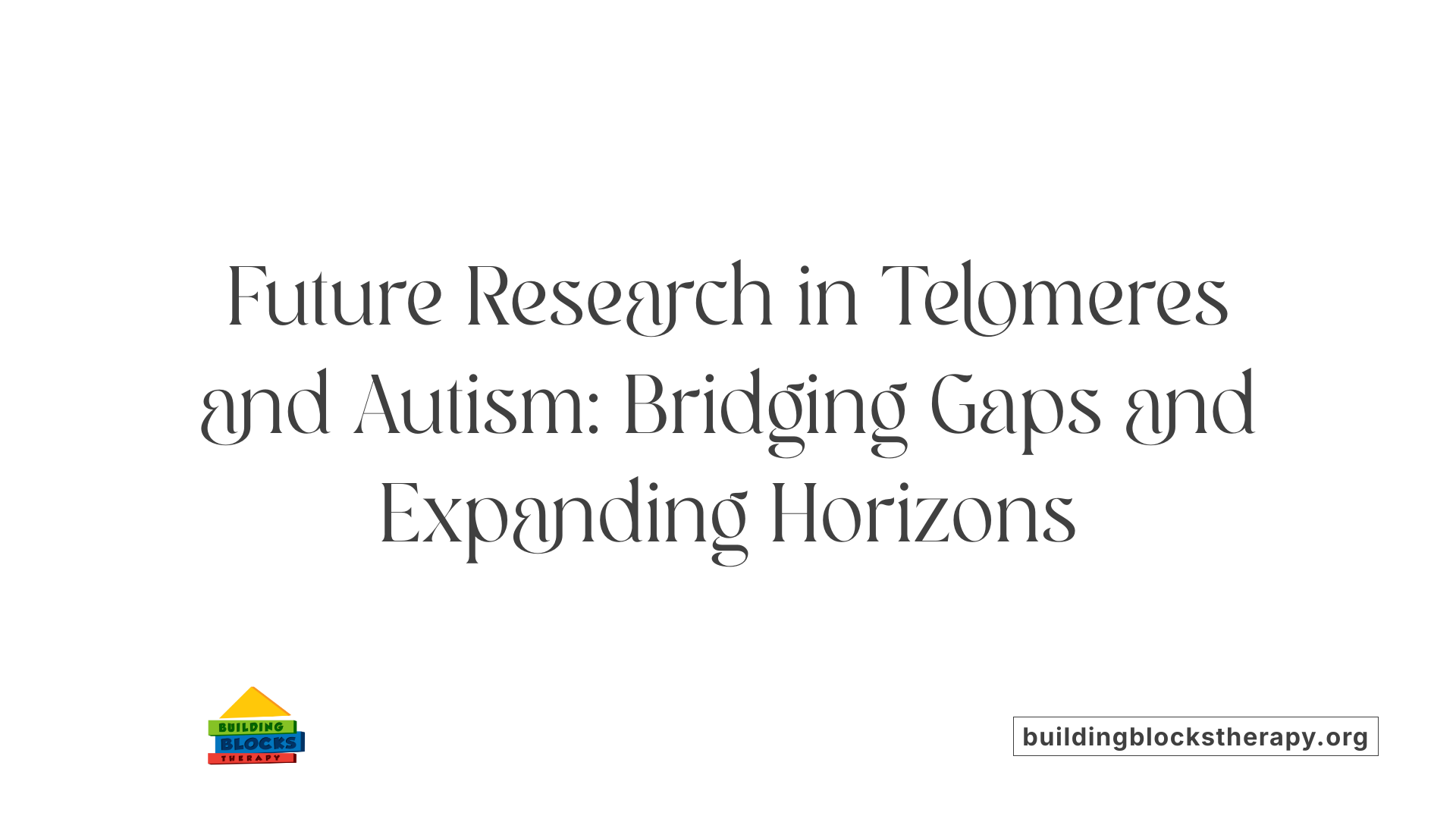
What areas require further research to understand the link between telomeres and autism?
Recent studies consistently find that children and adolescents with autism spectrum disorder (ASD) tend to have shorter telomeres (TL) when compared to typically developing (TD) peers. This shorter TL is associated with increased severity of sensory symptoms and may reflect underlying biological aging processes. Interestingly, unaffected siblings show intermediate TL lengths, positioning telomeres as potential markers of familial risk.
Despite these findings, the causality remains unclear. To clarify this relationship, longitudinal research is necessary. Such studies can help determine whether shortened telomeres precede ASD development or are a consequence of living with the disorder.
Why are standardized telomere measurement techniques important?
Currently, research utilizes various methods to measure TL, including quantitative PCR and other molecular assays. However, inconsistency in measurement techniques hampers the comparability and clinical translation of findings.
Developing and adopting standardized, reliable assays tailored for clinical use could improve diagnostic accuracy. Incorporating telomere length as an early biomarker may facilitate earlier intervention for children at risk.
How can research broaden to diverse populations and age groups?
Most existing studies focus on specific populations, often limited geographically or ethnically. Expanding research to include diverse groups will ensure the universality of telomere-related biomarkers.
Additionally, understanding how telomere dynamics change across different life stages will shed light on critical windows for intervention. Notably, parental age at birth influences TL in children with ASD, indicating a complex interaction that warrants further investigation.
What role might gene-environment interactions play in telomere dynamics related to ASD?
Oxidative stress and telomeric oxidation are increased in autistic children, suggesting environmental factors like oxidative stress, exposure to toxins, or lifestyle could impact telomere length.
Future studies should explore how specific environmental exposures interact with genetic predispositions to influence telomere maintenance. Such insights could open avenues for targeted prevention strategies focusing on reducing oxidative damage and supporting telomere integrity.
| Research Area | Current Status | Future Focus | Importance |
|---|---|---|---|
| Longitudinal Studies | Emerging but limited | Establish causality between TL and ASD | Critical for early detection and prevention |
| Measurement Standardization | Varies | Develop uniform tools for clinical assessment | Enhances comparability and clinical utility |
| Population Diversity | Underrepresented | Include diverse ethnic and age groups | Ensures generalizability of findings |
| Gene-Environment Interaction | Investigative | Clarify how external factors and genetics influence TL | Potential for targeted interventions |
Summary and Concluding Remarks
How do current findings link telomeres to autism spectrum disorder (ASD)?
Recent research consistently indicates that children and adolescents with ASD tend to have shorter telomeres (TL) in their blood cells compared to typically developing (TD) children. This shortening is not only observed in affected individuals but also extends to unaffected family members, especially those at high genetic risk, such as siblings and parents.
The scientific evidence suggests a correlation between shortened TL and the severity of sensory symptoms in ASD. For instance, children exhibiting more pronounced sensory issues often show greater telomere shortening. Additionally, biological markers of oxidative stress, like increased levels of 8-OHdG and altered antioxidant enzyme activities, are heightened in children with ASD, further linking oxidative damage to telomere attrition.
Interestingly, in parents of children with ASD, cognitive functions—but not autistic traits—are related to TL. This indicates a complex interplay between genetics, cellular aging, and neurodevelopmental traits.
While the association between shorter TL and ASD is well-supported, current studies suggest that shorter telomeres are a marker of cellular aging associated with ASD, rather than a causal factor. Mendelian randomization analyses show that shorter TL is linked to ASD but does not increase the risk when tested in reverse.
What are the implications for future research and clinical practice?
Understanding telomere dynamics offers promising avenues for early diagnosis and intervention. Since shortened telomeres and elevated telomeric oxidative damage are observed in children with ASD, these biomarkers could help identify at-risk individuals early, possibly even before overt clinical symptoms emerge.
Family and individual-based interventions, such as family training, have been associated with longer leukocyte telomeres, suggesting that environmental and behavioral strategies might influence cellular aging processes in ASD.
Moreover, examining telomere length in conjunction with markers of oxidative stress could deepen our understanding of ASD's underlying mechanisms. This involves exploring how oxidative damage accelerates telomere shortening and whether antioxidant therapies could mitigate some ASD symptoms.
What is the potential for telomere and oxidative stress markers as diagnostic tools?
The use of blood-based biomarkers, such as relative telomere length (RTL) and LINE-1 methylation levels, shows high predictive accuracy for ASD. Receiver Operating Characteristic (ROC) curve analyses demonstrate substantial area under the curve values (~0.82–0.89), indicating these markers could serve as reliable tools for early detection.
Children with ASD also exhibit increased telomeric oxidative lesions, which could act as supplementary markers to improve diagnostic sensitivity. Combining telomere length measures with assessments of oxidative stress might enhance the precision of early ASD diagnosis.
In summary, the convergence of evidence suggests that telomere shortening and oxidative damage are consistent features in ASD. These biological markers hold promise not only for understanding disease mechanisms but also for developing new diagnostic and therapeutic strategies in the future.
Harnessing Telomere Biology for Autism Insights and Interventions
The growing body of evidence linking telomere length and oxidative stress to autism spectrum disorder underscores the importance of integrating molecular biomarkers into research and clinical contexts. Although much remains to be understood about causality and the influence of external factors, current findings suggest that telomere dynamics could serve as valuable indicators for early diagnosis, assessment of severity, and potential therapeutic targets. Advancing our understanding of telomere biology not only provides insights into the cellular aging processes underlying neurodevelopmental disorders but also opens avenues for personalized interventions aimed at mitigating disease progression and improving quality of life for individuals with ASD.
References
- Telomere Length and Autism Spectrum Disorder Within the Family
- Causality between Autism Spectrum Disorder and Telomere Length
- Shorter telomere length in children with autism spectrum disorder is ...
- Association of Relative Telomere Length and LINE-1 Methylation ...
- Shorter telomere length in peripheral blood leukocytes is associated ...
- Differential Levels of Telomeric Oxidized Bases and TERRA ...
- Shortened Telomeres in Families With a Propensity to Autism
- Parental age at birth, telomere length, and autism spectrum ...
- Telomere Length and Autism Spectrum Disorder Within the Family
- Causality between Autism Spectrum Disorder and Telomere Length






